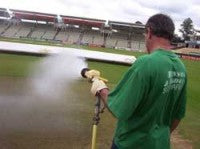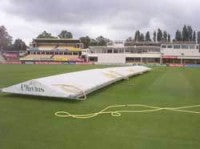Edgbaston prepares for 2nd Test
Edgbaston prepares for 2nd Test
By Laurence Gale MSc

Last week I managed to catch up with Steve Rouse, Head Groundsman at Warwickshire (The Bears) Cricket Club, as he was busy preparing the ground for the forthcoming second Test Match - England V West Indies.


Steve needed to get down as much water as possible before the Test match and other programmed fixture which follow, namely the 20/20 tournament on 7th August and a County game against Kent on the 11th August.
As soon as these wickets have been flooded they will be covered to keep the moisture in. Judging the amount of water to apply is critical, especially being so near to a Test. Steve cannot afford to have too much variation in surface wetness on the square during the match.

The wickets at Edgbaston are gradually being replaced with Ongar loam. This loam was introduced to the county clubs by Harry Brind from the ECB. Steve has recently reconstructed a number of new Ongar loam wickets on the main square. These new wickets will be ready for play next year.
Eventually, the aim is to have all Ongar loam wickets to provide consistency of play. It seems that most top flight clubs are now changing their wickets to Ongar loam. It poses an interesting debate. Do we want all the county club sides having the same loams wickets? Steve remembers vividly, when he was a player, the difference between the playing characteristics of the wicket varied dramatically from ground to ground. Yorkshire was always a green, slow, seaming wicket, Essex was a real bouncer and Glamorgan's pitch 
The Test wicket receives a daily routine of brushing (3 ways) and mowing (2 ways) and grass length is gradually reduced from 8mm down to 1mm by the day before the start. Rolling also continues using a 2 tonne roller until the day before. On the morning of the match Steve will roll for up to 2-3 hours using a light hand roller to remove the green tinge of colour from the wicket, cross rolling both down the length (stump to stump) and very slowly width ways.
Steve' s main concern in the build up, and during the Test, is the weather. Anticipating and reacting to the weather is a key part of any pitch preparations. All the works are governed by what the weather is doing or going to do. There are no books to advise, it's all down to experience.
This year's weather has certainly being a challenge, especially when trying to keep the wickets dry. The groundstaff have spent most of their time covering and uncovering the squares, which is often a time consuming and back breaking job, especially when having to drag large wet covers backward and forwards.
This year, however, Steve has being trying out some new breathable covers supplied by Total Turf Solutions. They are very light enabling them to be moved easily by two people but, more importantly, can be left on the ground longer without causing damage to the sward. Steve is very impressed with them.
The outfield has been sprayed with a fertiliser formulation put together by David Bates, the agronomist, who has been working with
The outfield is mowed daily using a TORO 520 triple mower at a cutting height of 9mm, which is reduced to 6mm for the test match. One of the main benefits of using the TORO is the time saved on cutting the outfield, it is now cut in two directions in about an hour.
Steve is confident that with all the hard work done, coupled with being blessed with some sunny weather, the ground will look fantastic during the Test.
